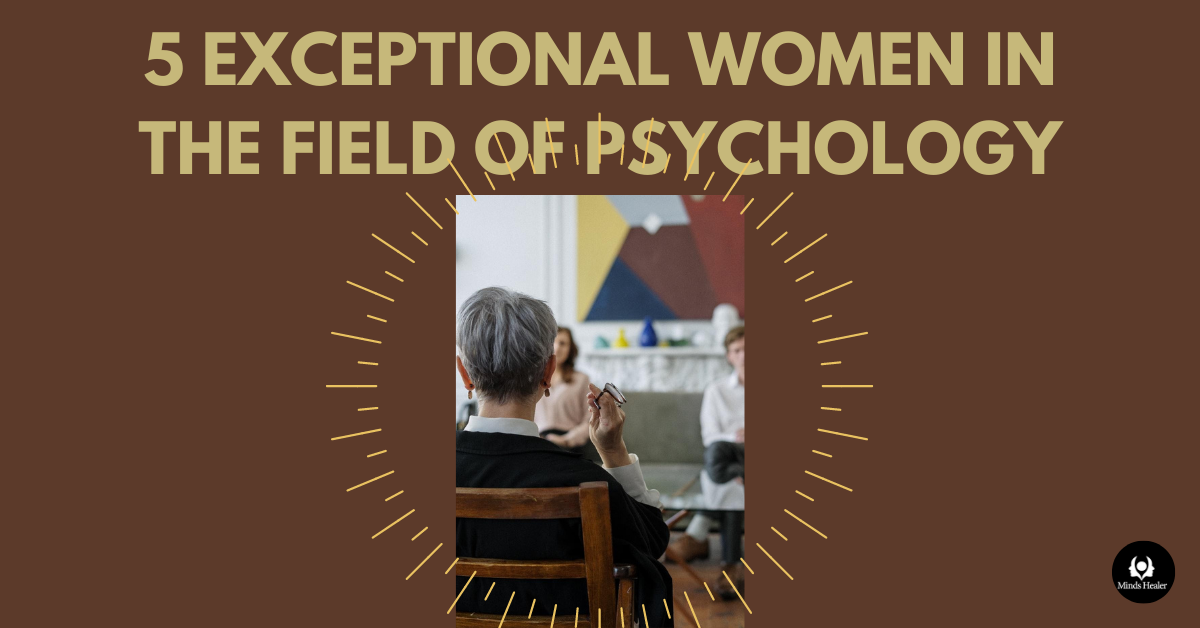It’s a well-established fact by now that women have been facing gender discrimination since time immemorial. In every field, in every occupation, women have always been looked down upon as “inferior” to men. This article celebrates some of the most remarkable contributions made by women in the field of psychology. Hence, we present to you (while there are more) 5 Exceptional Women in the Field of Psychology

No psychology textbook fails to mention some of the male pioneers who contributed to this field. The most famous ones being Sigmund Freud, Carl Jung, B.F. Skinner, John B. Watson, among many others. This is mainly because psychology, like many other areas of study, was heavily male-dominated during the early ages.
Women were either not given the opportunity to study alongside men or not rewarded with the recognition they deserved. Their work was heavily underplayed. As a result, a majority of the books in circulation today fail to recognize these women for their contributions.
5 Exceptional Women in the Field of Psychology.
Anna Freud
The youngest daughter to Sigmund Freud, Anna devoted herself mainly to child psychology. She was the earliest practitioner and founder of child psychoanalysis. In her early years, she used to teach elementary students, which ultimately drew her to the psyche of children.
Apart from child psychoanalysis, Anna Freud also played a major role as a founder of the various defense mechanisms like repression. These findings still play a major role in today’s world.
Throughout her lifetime, she made two significant publications, namely – Das Ich und die Abwehrmechanismen (1936; The Ego and Mechanisms of Defense, 1937) and another paper while serving as the chairman of the Vienna Psycho-Analytic Society. The latter outlined her approach to child psychoanalysis, while the former gave better motivation to ego psychology.
Mary Whiton Calkins
Mary Calkins etched her name in the history of psychology as the first female president of the American Psychological Association (APA). She is also known for her time as the president of the American Philosophical Association (1918).
Her most celebrated works include her contributions to the field of self-psychology and the invention of the paired-associate technique. She developed this technique while studying at Harvard University.
It included showing the study participants a series of colors paired with numbers and later testing their recollection of the pairs. Used as a technique to test memory, this study was later published by Edward B. Titchener who claimed recognition for its development.
Despite rightfully earning her doctorate degree in psychology from Harvard, she was never actually granted it on the grounds that she was a woman.
Mary Ainsworth

Ainsworth played a huge role in the field of child psychology. She pioneered the development of the four attachment styles between mother and child. Along with her colleague, Sylvia Bell, Mary developed the Strange Situation Test. The test primarily focuses on key elements with regard to the child and specifies four attachment styles – secure attachment, anxious-resistant insecure attachment, anxious-avoidant insecure attachment, and disorganized/disoriented attachment.
After earning a doctorate from the University of Toronto, Ainsworth taught psychology until she retired. Throughout her lifetime, she earned many awards including the Distinguished Contribution Award from the Maryland Psychological Association in 1973 and the Gold Medal for Scientific Contributions from the American Psychological Foundation in 1998.
Melanie Klein
Though Melanie never received formal education or a degree in the field of psychology, she developed the play therapy which is used widely today. This technique was developed when she started receiving treatment and studying with psychoanalyst Sandor Ferenczi.
He was the one to encourage her to psychoanalyze her own children. This led to the development of the infamous “play therapy”. Klein’s play technique ran completely opposite to Anna Freud’s findings who said that psychoanalyzing children was not possible. This caused many debates in the field of psychoanalysis.
As someone who had struggled with depression for a large part of her life, she wrote many psychoanalytic papers on the topic. They explained how unresolved childhood issues might be related to depression.
Karen Horney
Karen Horney was a prominent figure in the field of feminine psychology, self-psychology, and known for her theory of neurotic needs. Apart from these, she remembered for challenging Freud on his theory of penis envy.
Her theory of neurosis primarily laid focus on how humans use neuroses as a form of coping mechanism. She identified ten neuroses, namely– needs for affection, needs for social prestige, needs for power, needs for independence, ad so on. In contrast to Freud’s belief that neuroses stemmed from biological reasons, Horney stated that cultural differences played a bigger part in these neuroses.
Karen rejected the findings of Freud with regard to his “penis envy” theory. She found it extremely inaccurate as well as demeaning to women. Instead, she proposed a theory called “womb envy” which stated that men envied women because of their ability to give birth and often felt “inferior” to them.
She advocated self-psychology and passionately believed that through self-analysis and self-help, individuals can therapize themselves. She laid heavy emphasis on how we play a major role in our own mental health.
This was our list of some of the most notable women in the field of psychology. Though they were as capable as men, if not more, they did not get the recognition they deserved. If you would like to read about other women in psychology, we suggest Elizabeth Loftus, Marsha Linehan, Brene Brown, and Margaret Floy Washburn, among many other greats.
Please visit our website to read more related blogs!
References:



